Initially this guide displays common species likely to be flitting right now. Use the selectors below to view by color, include rare species, or search by name.
Over 100 species of butterflies and skippers have been identified in the Los Alamos area, and over 150 in the Jemez Mountains. This guide mainly includes the common species, but even some of these are difficult to tell apart. For example, we have 4 species of fritillaries with very subtle differences.
In addition, there are an equally large number of moths in the area. However, most moths are active at night they are not as readily observed. Therefore, this guide primarily focuses on the moths that are more obvious due to their size or the fact that they are active during the day. The easiest way to tell a moth from a butterfly is to look at the antennae. The moth has feathery or saw-edged antennae, while the butterfly has antennae that look like a long shaft with a bulb at the end. In addition, moths and butterflies tend to hold their wings differently. Moths tend to fold their wings down to form a tent over their abdomen, hiding it from view. In contrast, butterflies usually hold their wings vertically up over their backs.
Both butterflies and moths develop through a process of complete metamorphosis with four stages: egg, larva, pupa, and adult. The young are very different from the adults and often eat different types of food. Pictures of the caterpillar larva for many of the species in this guide are included.
Get current information by joining PEEC Butterfly Watchers and taking a look at PEEC’s Butterfly, Skipper, and Moth set on Flickr. Additional information can be found in Butterflies through Binoculars: The West and Kaufman Field Guide to Butterflies of North America. Close-focusing binoculars are the best equipment for watching adult butterflies and moths.
Butterfly and Moth References
BugGuide
Butterflies and Moths of North America
Cary, S., 2009 Butterfly Landscapes of New Mexico. New Mexico Magazine
eNature
Glassberg, J., 2001 Butterflies Through Binoculars: The West. Oxford University Press
How to Build a Butterfly Garden
Subject Area Experts (all guides)
Steve Cary (butterflies)
Beth Cortright (insects)
Terry Foxx (invasive plants)
Leslie Hansen (mammals)
Richard Hansen (fish, mammals)
Dorothy Hoard (butterflies, trees)
Chick Keller (flowers, herbarium)
Shari Kelley (geology)
Kirt Kempter (geology)
Garth Tietjen (reptiles)
David Yeamans (birds)
Web Development and Content Management
Pat Bacha
Jennifer Macke
Graham Mark
Akkana Peck
Contact
Please contact us for local nature questions and sightings. We welcome comments, corrections, and additions to our guides.
For more information about local nature, please visit our Nature Blog or subscribe to PEEC This Week.
Make Selection
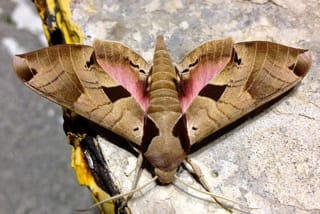 Photo: Angelique Harshman 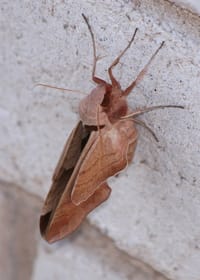 Photo: J. N. Stuart 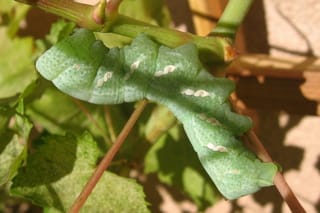 Photo: Johnida Dockens | Achemon Sphinx(Eumorpha achemon)Family: Sphingidae (Sphinx Moths and Hawkmoths) Size: 3.4 - 3.8 in (9 - 10 cm) Color: brown, pink Flits: Jun 01 - Jul 31 Status: native; common Food source: nectar from flowers such as Jimpson weed and four o’clocks Host: various vines and ivies Habitat: wooded and scrubby habitats and inhabited areas The adults usually only fly at night flitting between plants with fragrant flowers and long long flora tubes. They use their very long tongues to reach the nectar in the bottom of these flowers. There are three different colored forms of larvae: light green, reddish orange, and tan to brown. The larvae can often be seen in vineyards feeding on the vine leaves. Info Photos |
 Photo: Chick Keller 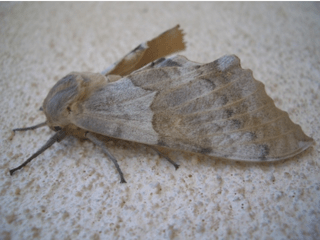 Photo: H. Trudell 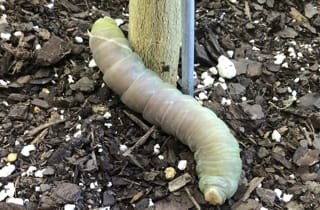 Photo: jnewt83 | Western Popular Sphinx, Big Popular Sphinx(Pachysphinx occidentalis)Family: Sphingidae (Sphinx Moths and Hawkmoths) Size: 5.2 - 5.8 in (13 - 15 cm) Color: brown, yellow Flits: May 15 - Sep 01 Status: native; common Food source: adults do not feed Host: cottonwood, poplar, and willow Habitat: suburban and riparian areas There are two colors forms of the Western Popular Sphinx, a pale form with yellow brown forewings and a dark form that is more gray. There is a touch of crimson on the upper-side of the hind wings along with two distinctive dark lines. Females lay their eggs on the leaves of Populus and Salix tree species. The fully-grown caterpillars spend the winter in the ground in a shallow hole as pupa. Info Photos |
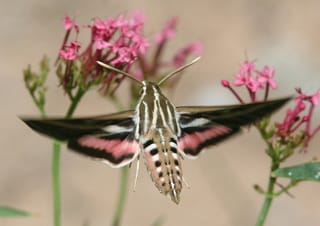 Photo: Selvi Viswanathan 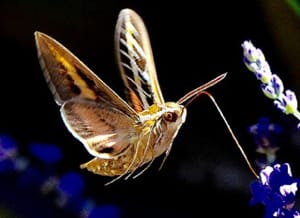 Photo: Larry Lamsa 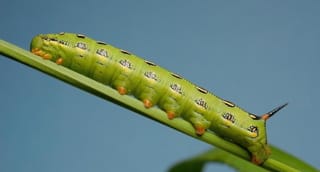 Photo: Joseph Berger | White-lined Sphinx, Hummingbird Moth(Hyles lineata)Family: Sphingidae (Sphinx Moths and Hawkmoths) Size: 2 - 3 in (5 - 8 cm) Color: black, brown, pink, white Flits: Jun 01 - Sep 30 Status: native; common Food source: nectar from a variety of flowers including columbines, larkspurs, clovers, thistles and Jimson weed Host: large range of trees and shrubs Habitat: areas with flowers in full bloom The White-lined Sphinx, as well as several other species, go by the nickname of “Hummingbird Moth” due to their rapid wing movement that resembles a hummingbird in flight. The adults primarily feed from dusk to dawn but occasionally can be seen during daylight hours. Although several generations of this moth may occur in a year, typically they are most obvious during July and August. Periodic population buildups occur stimulating emigrations to colonize new areas. Larvae can vary in color from yellow and black to lime green and black. When larvae are ready to pupate, they burrow into the soil and stay there for about three weeks before emerging as adults. Info Photos |
